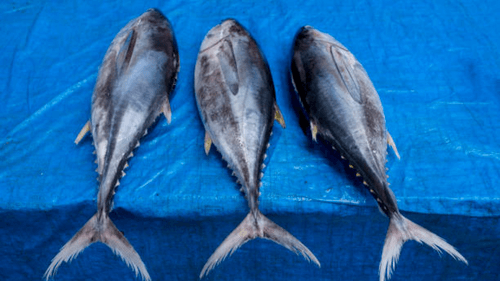Can you freeze tuna? Best freezing method
Tuna sales in the US are through the roof. According to the National Fisheries Institute, Americans eat a staggering 1 billion pounds of canned and pouched tuna annually. To put this into perspective, only sugar and coffee surpass the tuna sales per foot of shelf space in the grocery store. But the burning question is, can you freeze tuna?

Did you know that a 612 lb tuna sold at Japan’s first tuna auction of the year for $3.1 million? The mind-boggling figure was paid for the bluefin tuna, which is an endangered species.
This article will look at how to freeze tuna for the best-preserved product. We answer many frequently asked questions to bring you the information to extend your culinary knowledge.
Let’s dive in.
Does tuna expire?

Fresh tuna expires. If you eat fresh tuna, you will know the shelf life is limited. Fresh tuna will only last in the fridge for 1 to 2 days before the color changes from deep pink to something pale and maybe milky.
When tuna is line caught, it must be on ice within minutes of being out of the water. If not, the histamine in the tuina starts to build up and can spoil the fish quickly. If you eat fresh tuna and get that tickle in your throat, that’s the histamine.
Histamine for some people can be severe and include rash, facial flushing, vomiting, diarrhea, dyspnea, a tight feeling in the throat, headache, or a metallic or peppery taste in the mouth. This happens within two hours of eating the fish.
But the good news is that histamine and bacterial growth are controlled on board the ship with good cold management, meaning the fish are on ice within minutes of being caught.
How about canned tuna? Does that expire? Well, it will inevitably expire at some point, but it will certainly last a couple of years past its expiry date.
If you have canned tuna, you can ignore the expiry date, which indicates when the tuna is at peak condition in the can, and there is nothing to do with expiry. It is a food quality issue, not safety, so don’t get hung up on canned foods’ expiry dates.
But what if you have a lot of leftover canned tuna that can be frozen, or has the pasteurization removed the fish’s natural properties to allow freezing?
The great thing about tuina is it’s versatile and is receptive to being frozen. Even if you have cooked with it like a tuna bake, the tuna will freeze perfectly, preventing waste.
Does tuna need to be refrigerated?

Yes. Despite tuna being a large ocean predator and having firm muscular meat, it is a delicate fish and meat to deal with and will spoil very quickly. If you have fresh tuna, the best way to manage it is to eat it the same day as purchased, but before it hits the grill, place the tuna in the fridge to prevent bacterial buildup.
If you are lucky, fresh tuna in the fridge has a shelf life of 2 days. Stored in the fridge, ensure the fish is dry, wrap it firmly with cling film, and store it in the coldest part of the fridge at around 31℉.
Once you open a can of tuna and have not used the contents, it needs to be stored in the fridge in an airtight container. It will last for 3 days if stored in this method.
Tuna pouches should be refrigerated after opening and will have the same shelf life as canned tuna.
Does tuna have to be covered in the fridge?
Yes, but the coverage is different. If you have tuna steaks, prepare a tray of crushed ice. If possible, don’t stack the tuna steaks.
Cover the steaks with a paper towel and then seal the lid. This is the best method to store tuna steaks in the fridge. If you have to stack them due to limited space, place a paper towel between each tuna steak.
Canned tuna has an aroma that could taint other foods in the fridge, so place it in an airtight container. This will lock that aroma in and help prevent bacterial growth.
Can you put warm tuna in the fridge?

It is not advisable, even if the tuna is part of a big dish such as tuna bake.
Your fridge temperature will be 40℉ -18℃ or a little lower. Placing a warm tuna in the fridge will elevate its temperature while it radiates heat.
Your fridge may not be as efficient as you might have thought at removing heat. Most fridges take hours to come to 40℉ after being switched on after cleaning.
Tuna sitting at a temperature of 40-140℉ is in the food danger zone. It’s not just your tuna. It is the contents of the entire fridge, according to the USDA.
Above 40℉-18℃ bacterial growth on perishable foods will accelerate exponentially. It should be discarded if the food remains at an elevated temperature above 40℉-18℃ for just two hours.
How long can tuna sit out?
2 hours. Fresh tuna or canned and pouched, if open, will all have the same shelf life sitting at room temperature.
According to the USDA, perishable foods such as fresh and processed tuna can only sit out for two hours before the bacterial load accelerates to the point where the tuna is likely to cause food poisoning if eaten.
This applies to all perishable foods and not just tuna.
How long does tuna last in the fridge?
Fresh tuna will last for a two-days maximum but should be consumed the day it is purchased. Canned tuna, when open, will last for three days stored in an airtight container. Tuna pouches, when open, last for three days in the fridge.
Both canned tuna and tuna in pouches are not required to be stored in the fridge if they are not open. It will not extend the tuna’s life if you store them in the fridge.
Does frozen tuna go bad?
Fresh tuna cannot simply be frozen like other foods. Unfrozen tuna may acquire a bad flavor and odor. To prevent freezer burn, fresh tuna must be thoroughly frozen.
Tuna that has been improperly frozen may also contain pathogens and be unhealthy. Tuna that has been properly frozen will be free of bacteria when cooked.
This is the best freezing method for tuna
- You will need a solution of brine. For each cup of water you used, add 1 tablespoon of salt and stir until the salt is completely dissolved. For instance, add 16 tablespoons (1 cup) of salt to 1 gallon (16 cups) of water.
The brine solution is going to prevent the tuna from dehydrating while frozen.
- Place the tuna in the brine solution and leave for 1 minute. This will make the flesh firm.
- Wrap the tuna in cling wrap, which should be wrapped thoroughly and tightly. When the wrapping is complete, it is best to store the tuna in a suitably sized freezer bag. Make sure it is a freezer bag. Many sealable bags are not.
- When the tuna is in the sealable freezer bag, squeeze as much air from the bag as possible to help prevent freezer burn.
- Place the tuna in the coldest part of the freezer. If you can set the freezer to lower 0℉ do it.
Use only the freshest tuna you can find for the best results. Following this method, your tuna will freeze perfectly for three months.
There are other ways to freeze tuna, such as by freezing the tuna in a block of ice, but if you are freezing a lot of tuna, the weight of the water may place structural stress on the freeze draws and cause damage.
Canned tuna, if open, can be frozen for three months in Ziploc bags.
How do you thaw tuna?
Tuna should be removed from the bag and placed on a paper towel to dry while it defrosts. To remove the meat’s surface moisture, pat it dry with one or two paper towels.
Fish should be placed on a plate on a paper towel that has been laid down first. Wrap the fish in towels.
Place the platter inside the refrigerator. Whenever the paper towels become soaked with moisture from the meat, you should change them, possibly once or twice during the day.
When towels become moist, replace them as frequently as possible because the moisture might spoil seafood faster.
Thaw canned tuna in the fridge and leave it in the Ziploc bag to retain moisture.
Final thoughts
Fresh tuna should be consumed on the day of purchase to enjoy the fish at its best. Stored in the fridge, you have 48 hours to cook the fish as tuna spoils fast. Keep the tuna dry.
There is more to freezing tuna than meets the eye, and the main thing is to keep the fish dry and the flesh firm. Ice crystals will form in water making the fish mushy if you don’t take care of the preparation process before freezing.
Tuna, when caught, is stored in ice in a very cold freezer so the fish freezes fast. Make your freezer as cold as possible when freezing tuna.





